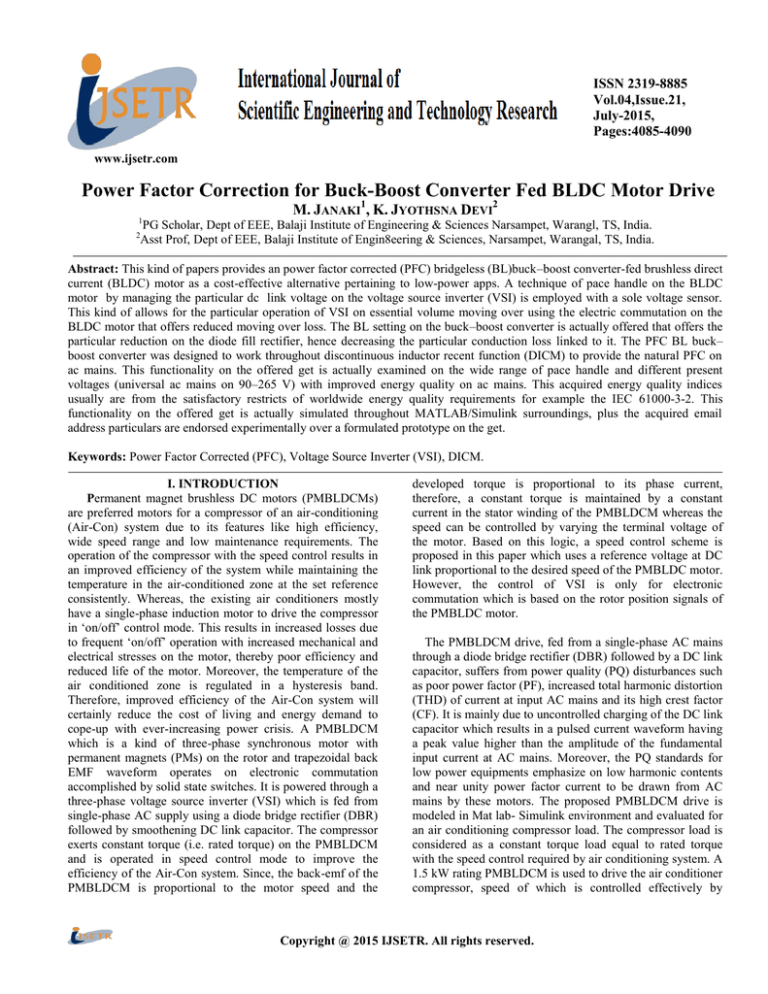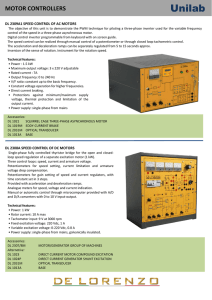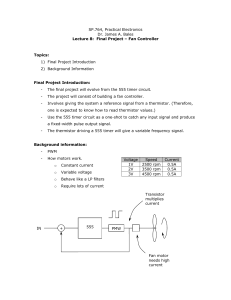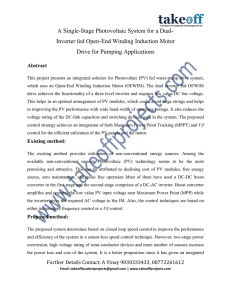
ISSN 2319-8885
Vol.04,Issue.21,
July-2015,
Pages:4085-4090
www.ijsetr.com
Power Factor Correction for Buck-Boost Converter Fed BLDC Motor Drive
M. JANAKI1, K. JYOTHSNA DEVI2
1
2
PG Scholar, Dept of EEE, Balaji Institute of Engineering & Sciences Narsampet, Warangl, TS, India.
Asst Prof, Dept of EEE, Balaji Institute of Engin8eering & Sciences, Narsampet, Warangal, TS, India.
Abstract: This kind of papers provides an power factor corrected (PFC) bridgeless (BL)buck–boost converter-fed brushless direct
current (BLDC) motor as a cost-effective alternative pertaining to low-power apps. A technique of pace handle on the BLDC
motor by managing the particular dc link voltage on the voltage source inverter (VSI) is employed with a sole voltage sensor.
This kind of allows for the particular operation of VSI on essential volume moving over using the electric commutation on the
BLDC motor that offers reduced moving over loss. The BL setting on the buck–boost converter is actually offered that offers the
particular reduction on the diode fill rectifier, hence decreasing the particular conduction loss linked to it. The PFC BL buck–
boost converter was designed to work throughout discontinuous inductor recent function (DICM) to provide the natural PFC on
ac mains. This functionality on the offered get is actually examined on the wide range of pace handle and different present
voltages (universal ac mains on 90–265 V) with improved energy quality on ac mains. This acquired energy quality indices
usually are from the satisfactory restricts of worldwide energy quality requirements for example the IEC 61000-3-2. This
functionality on the offered get is actually simulated throughout MATLAB/Simulink surroundings, plus the acquired email
address particulars are endorsed experimentally over a formulated prototype on the get.
Keywords: Power Factor Corrected (PFC), Voltage Source Inverter (VSI), DICM.
I. INTRODUCTION
Permanent magnet brushless DC motors (PMBLDCMs)
are preferred motors for a compressor of an air-conditioning
(Air-Con) system due to its features like high efficiency,
wide speed range and low maintenance requirements. The
operation of the compressor with the speed control results in
an improved efficiency of the system while maintaining the
temperature in the air-conditioned zone at the set reference
consistently. Whereas, the existing air conditioners mostly
have a single-phase induction motor to drive the compressor
in „on/off‟ control mode. This results in increased losses due
to frequent „on/off‟ operation with increased mechanical and
electrical stresses on the motor, thereby poor efficiency and
reduced life of the motor. Moreover, the temperature of the
air conditioned zone is regulated in a hysteresis band.
Therefore, improved efficiency of the Air-Con system will
certainly reduce the cost of living and energy demand to
cope-up with ever-increasing power crisis. A PMBLDCM
which is a kind of three-phase synchronous motor with
permanent magnets (PMs) on the rotor and trapezoidal back
EMF waveform operates on electronic commutation
accomplished by solid state switches. It is powered through a
three-phase voltage source inverter (VSI) which is fed from
single-phase AC supply using a diode bridge rectifier (DBR)
followed by smoothening DC link capacitor. The compressor
exerts constant torque (i.e. rated torque) on the PMBLDCM
and is operated in speed control mode to improve the
efficiency of the Air-Con system. Since, the back-emf of the
PMBLDCM is proportional to the motor speed and the
developed torque is proportional to its phase current,
therefore, a constant torque is maintained by a constant
current in the stator winding of the PMBLDCM whereas the
speed can be controlled by varying the terminal voltage of
the motor. Based on this logic, a speed control scheme is
proposed in this paper which uses a reference voltage at DC
link proportional to the desired speed of the PMBLDC motor.
However, the control of VSI is only for electronic
commutation which is based on the rotor position signals of
the PMBLDC motor.
The PMBLDCM drive, fed from a single-phase AC mains
through a diode bridge rectifier (DBR) followed by a DC link
capacitor, suffers from power quality (PQ) disturbances such
as poor power factor (PF), increased total harmonic distortion
(THD) of current at input AC mains and its high crest factor
(CF). It is mainly due to uncontrolled charging of the DC link
capacitor which results in a pulsed current waveform having
a peak value higher than the amplitude of the fundamental
input current at AC mains. Moreover, the PQ standards for
low power equipments emphasize on low harmonic contents
and near unity power factor current to be drawn from AC
mains by these motors. The proposed PMBLDCM drive is
modeled in Mat lab- Simulink environment and evaluated for
an air conditioning compressor load. The compressor load is
considered as a constant torque load equal to rated torque
with the speed control required by air conditioning system. A
1.5 kW rating PMBLDCM is used to drive the air conditioner
compressor, speed of which is controlled effectively by
Copyright @ 2015 IJSETR. All rights reserved.
M. JANAKI, K. JYOTHSNA DEVI
controlling the DC link voltage. The detailed data of the
III. INVERTER OPARATION
motor and simulation parameters are given in Appendix. The
Inverter is power electronic circuit that converts a direct
performance of the proposed PFC drive is evaluated on the
current into an alternative current power of desired
basis of various parameters such as total harmonic distortion
magnitude and frequency with the use of appropriate
(THDi) and the crest factor (CF) of the current at input AC
transformers, switching and control circuits. The inverters
mains, displacement power factor (DPF), power factor (PF)
find their application in modern ac motor and uninterruptible
and efficiency of the drive system (ηdrive) at different speeds
power supplies. Static inverters have no moving parts and are
of the motor. Moreover, these parameters are also evaluated
used in a wide range of applications, from small switching
for variable input AC voltage at DC link voltage of 416 V
power supplies in computers, to large electric utility highwhich is equivalent to the rated speed (1500 rpm) of the
voltage direct current applications that transport bulk power.
PMBLDCM.
Inverters are commonly used to supply AC power from DC
sources such as solar panels or batteries. The electrical
inverter is a high-power electronic oscillator. It is so named
II. POWER FACTOR CORRECTION (PFC)
An electric utility's power load on an electrical distribution
because early mechanical AC to DC converters were made to
system fall into one of three categories; resistive, inductive or
work in reverse, and thus were “inverted", to convert DC to
capacitive. In most industrial facilities, the most common
AC. The inverter performs the opposite function of a
power usages are "inductive." Examples of inductive loads
rectifier.
include transformers, fluorescent lighting and AC induction
A. Classification of Inverter
motors. Most inductive loads use a conductive coil winding
1. Based on the source used
to produce an electromagnetic field which permits the motor
Voltage source inverter
to function. All inductive loads require two different types of
Current source inverter
power for the motor to operate: Active power (measured in
2. Based on switching methods
kW or kilowatts) - this power produces the motive force
Pulse width modulation inverters
Reactive power (kvar) - this energizes the magnetic field of
Square wave inverters
the motor. The operating power from the distribution system
3. Based on switching devices used
is composed of both active (working) and reactive (non Transistorized inverter
working) elements. The active power does useful work in
Thyristorized inverter
driving the motor whereas the reactive power only provides
4. Based on the inversion principle
the magnetic field. Unfortunately, electric utility's customers
Resonant inverter
are charged for both active and reactive power. Example: A
Non- Resonant inverter
customer's power factor drops, the system becomes less
efficient.
IV. PROPOSED SPEED CONTROL SCHEME OF
PMBLDC MOTOR FOR AIR CONDITIONER
A drop from 1.0 to 0.9 results in 15% more current being
The proposed speed control scheme (as shown in Fig.1)
required for the same load. A power factor of 0.7 requires
controls reference voltage at DC link as an equivalent
approximately 40% more current; and a power factor of 0.5
reference speed, thereby replaces the conventional control of
requires approximately 100% (twice as much) to handle the
the motor speed and a stator current involving various
same load. The answer to these problems is to reduce the
sensors for voltage and current signals. Moreover, the rotor
reactive power drawn from the supply by improving the
position signals are used to generate the switching sequence
power factor. If an AC motor were 100% efficient it would
for the VSI as an electronic commutator of the PMBLDC
consume only active power. However, since most AC motors
motor. Therefore, rotor-position information is required only
are only 75% to 80% efficient, they operate at a lower power
at the commutation points, e.g., every 60°electrical in the
factor. This means inefficient and even "wasteful" energy
three phase. The rotor position of PMBLDCM is sensed
usage and cost efficiency because most electric utilities
using hall effect position sensors and used to generate
charge penalties for poor, inefficient power factor. Simply
switching sequence for the VSI as shown in Table-I. The DC
installing capacitors will improve a commercial or industrial
link voltage is controlled by a half-bridge buck DC-DC
company's power factor and will result in savings on their
converter based on the duty ratio (D) of the converter. For a
electricity bill every month. An additional potential benefit
fast and effective control with reduced size of magnetic and
for correcting poor power factor includes. Reduction of
filters, a high switching frequency is used; however, the
heating losses in transformers and distribution equipment
switching frequency (fs) is limited by the switching device
Longer equipment life
used, operating power level and switching losses of the
device. Metal oxide field effect transistors (MOSFETs) are
A. BLDC motors
used as the switching device for high switching frequency in
BLDC motors find applications in every segment of the
the proposed PFC converter. However, insulated gate bipolar
market. Automotive, appliance, industrial controls,
transistors (IGBTs) are used in VSI bridge feeding
automation, aviation and so on, have applications for BLDC
PMBLDCM, to reduce the switching stress, as it operates at
motors. Out of these, we can categorize the type of BLDC
lower frequency compared to PFC switches. The PFC control
motor control into three major types
scheme uses a current control loop inside the speed control
• Constant load
loop with current multiplier approach which operates in
• Varying loads
continuous conduction mode (CCM) with average current
• Positioning applications
control.
International Journal of Scientific Engineering and Technology Research
Volume.04, IssueNo.21, July-2015, Pages: 4085-4090
Power Factor Correction for Buck-Boost Converter Fed BLDC Motor Drive
The control loop begins with the comparison of sensed DC
(4)
link voltage with a voltage equivalent to the reference speed.
The
PFC
converter
is
designed
for
a
base
DC
link
voltage
The resultant voltage error is passed through a proportionalof Vdc = 400 V at Vin = 198 V from Vs = 220 Vrms. The
integral (PI) controller to give the modulating current signal.
turn‟s ratio of the high frequency transformer (N2/N1) is
This signal is multiplied with a unit template of input AC
taken as 6:1 to maintain the desired DC link voltage at low
voltage and compared with DC current sensed after the DBR.
input AC voltages typically at 170V. Other design data are fs
The resultant current error is amplified and compared with
= 40 kHz, Io = 4 A, ΔVCd= 4 V (1% of Vdc), ΔILo= 0.8 A
saw-tooth carrier wave of fixed frequency (fs) in unipolar
(20% of Io). The design parameters are calculated as Lo=2.0
scheme (as shown in Fig.4.2) to generate the PWM pulses for
mH, Cd=1600 μF.
the half-bridge converter. For the current control of the
PMBLDCM during step change of the reference voltage due
to the change in the reference speed, a voltage gradient less
than 800 V/s is introduced for the change of DC link voltage,
which ensures the stator current of the PMBLDCM within
the specified limits (i.e. double the rated current).
Fig 2. PWM control of the buck half-bridge converter.
V. RESULTS AND DISCUSSIONS
A. Simulation Model
Fig1. Control schematic of Proposed Bridge-buck PFC
converter fed PMBLDCM drive.
B. Design of PFC Buck Half-Bridge Converter Based
PMBLDCM Drive
The proposed PFC buck half-bridge converter is designed
for a PMBLDCM drive with main considerations on PQ
constraints at AC mains and allowable ripple in DC link
voltage. The DC link voltage of the PFC converter is given as
(1)
Where N1, N21, N22 are number of turns in primary,
secondary upper and lower windings of the high frequency
(HF) isolation transformer, respectively Vin is the average
output of the DBR for a given AC input voltage (Vs) related
as,
Fig3. Simulation Model.
(2)
A ripple filter is designed to reduce the ripples introduced in
the output voltage due to high switching frequency for
constant of the buck half-bridge converter. The inductance
(Lo) of the ripple filter restricts the inductor peak to peak
ripple current (ΔILo) within specified value for the given
switching frequency (fs), whereas, the capacitance (Cd) is
calculated for a specified ripple in the output voltage (ΔVCd).
The output filter inductor and capacitor are given as,
Fig4. Proposed speed control scheme of PMBLDC motor
for air conditioner.
International Journal of Scientific Engineering and Technology Research
Volume.04, IssueNo.21, July-2015, Pages: 4085-4090
(3)
M. JANAKI, K. JYOTHSNA DEVI
B. Discussion on Simulation Results
1. Starting performance of the PMBLDCM drive at 900
rpm.
Fig 6. PMBLDCM drive under speed variation from 900
rpm to 1500 rpm.
3. PMBLDCM drive under speed variation from 900 to
300 rpm
Fig 5. Starting performance of the PMBLDCM drive at
900 rpm.
The performance of the proposed PMBLDCM drive fed
from 220 V AC mains during starting at rated torque and 900
rpm speed is shown in Fig. 5. A rate limiter of 800 V/s is
introduced in the reference voltage to limit the starting
current of the motor as well as the charging current of the DC
link capacitor. The PI controller closely tracks the reference
speed so that the motor attains reference speed smoothly
within 0.35 sec while keeping the stator current within the
desired limits i.e. double the rated value. The current (is)
waveform at input AC mains is in phase with the supply
voltage (vs) demonstrating nearly unity power factor during
the starting.
2. PMBLDCM drive under speed variation from 900 to
1500 rpm
During Transient Condition shows the performance of the
drive during the speed control of the compressor. The
reference speed is changed from 900 rpm to 1500 rpm for the
rated load performance of the compressor; It is observed that
the speed control is fast and smooth in either direction i.e.
acceleration or retardation with power factor maintained at
nearly unity value. Moreover, the stator current of
PMBLDCM is within the allowed limit (twice the rated
current) due to the introduction of a rate limiter in the
reference voltage. the results are shown like voltage (vs) and
current (is) waveforms at AC mains, DC link voltage (Vdc),
speed of the motor (N), developed electromagnetic torque of
the motor (Te), the stator current of the motor for phase „a‟
(Ia), and shaft power output (Po).
Fig 7. PMBLDCM drive under speed variation from 900
rpm to 300 rpm.
During Transient Condition shows the performance of the
drive during the speed control of the compressor. The
reference speed is changed from 900 rpm to 300 rpm for
performance of the compressor at light load. It is observed
that the speed control is fast and smooth in either direction
i.e. acceleration or retardation with power factor maintained
at nearly unity value. Moreover, the stator current of
PMBLDCM is within the allowed limit (twice the rated
current) due to the introduction of a rate limiter in the
reference voltage. the results are shown like voltage (vs) and
current (is) waveforms at AC mains, DC link voltage (Vdc),
speed of the motor (N), developed electromagnetic torque of
the motor (Te), the stator current of the motor for phase „a‟
(Ia), and shaft power output (Po).
International Journal of Scientific Engineering and Technology Research
Volume.04, IssueNo.21, July-2015, Pages: 4085-4090
Power Factor Correction for Buck-Boost Converter Fed BLDC Motor Drive
During Steady State Condition: The speed control of the
4. Performance of the PMBLDCM drive at 300 rpm
PMBLDCM driven compressor under steady state condition
is carried out for speed at 900 rpm and the results are shown
like voltage (vs) and current (is) waveforms at AC mains, DC
link voltage (Vdc), speed of the motor (N), developed
electromagnetic torque of the motor (Te), the stator current of
the motor for phase „a‟ (Ia), and shaft power output (Po).
6. Performance of the PMBLDCM drive at 1500 rpm
Fig 8. Performance of the PMBLDCM drive at 300 rpm.
During Steady State Condition: The speed control of the
PMBLDCM driven compressor under steady state condition
is carried out for speed at 300 rpm and the results are shown
like voltage (vs) and current (is) waveforms at AC mains, DC
link voltage (Vdc), speed of the motor (N), developed
electromagnetic torque of the motor (Te), the stator current of
the motor for phase „a‟ (Ia), and shaft power output (Po).
5. Performance of the PMBLDCM drive at 900 rpm
Fig 10. Performance of the PMBLDCM drive at 1500
rpm.
During Steady State Condition: The speed control of the
PMBLDCM driven compressor under steady state condition
is carried out for speed at 1500 rpm and the results are shown
like voltage (vs) and current (is) waveforms at AC mains, DC
link voltage (Vdc), speed of the motor (N), developed
electromagnetic torque of the motor (Te), the stator current of
the motor for phase „a‟ (Ia), and shaft power output (Po).
Fig 9. Performance of the PMBLDCM drive at 900 rpm.
VI. CONCLUSION
A new speed control strategy of a PMBLDCM drive is
validated for a compressor load of an air conditioner which
uses the reference speed as an equivalent reference voltage at
DC link. The speed control is directly proportional to the
voltage control at DC link. The rate limiter introduced in the
reference voltage at DC link effectively limits the motor
current within the desired value during the transient condition
(starting and speed control). The additional PFC feature to
the proposed drive ensures nearly unity PF in wide range of
speed and input AC voltage. Moreover, power quality
parameters of the proposed PMBLDCM drive are in
conformity to an International standard IEC 61000-3-2. The
proposed drive has demonstrated good speed control with
energy efficient operation of the drive system in the wide
range of speed and input AC voltage. The proposed drive has
been found as a promising candidate for a PMBLDCM
driving Air-Con load in 1-2 kW power range.
International Journal of Scientific Engineering and Technology Research
Volume.04, IssueNo.21, July-2015, Pages: 4085-4090
M. JANAKI, K. JYOTHSNA DEVI
[13] S.K. Han, H.K. Yoon, G.W. Moon, M.J. Youn, Y.H.
VII. FUTURE SCOPE
The proposed drive has demonstrated good speed control
Kim and K.H. Lee, “A new active clamping zero-voltage
with energy efficient operation of the drive system in the
switching PWM current-fed half-bridge converter,” IEEE
wide range of speed and input AC voltage. Moreover, power
Trans. Power Electron., vol. 20, no. 6, pp. 1271 – 1279, Nov.
quality indices of the proposed PMBLDCM drive are
2005.
inconformity to the international standard IEC 61000-3-2.
[14] R.T.Bascope, L.D.Bezerra, G.V.T.Bascope, D.S.
The proposed drive has been found as a most promising drive
Oliveira, C.G.C.Branco, and L.H.C. Barreto, “High
for a variable speed application of an air conditioner 1-2 kW
frequency isolation on-line UPS system for low power
power range. Improved power quality is observed with
applications,” in Proc. IEEE APEC‟08, 2008 pp.1296 – 1302.
almost unity power factor and improved efficiency of the
drive in a wide range of the speed and an AC input voltage.
Author’s Profile:
A bridge DC-DC converter, connected between the VSI and
M.Janaki, Studying Mtech in Balaji
the DBR fed from single-phase AC mains controls DClink
Institute of Engineering & Sciences
voltage of the VSI feeding the PMBLDCM while
Narsampet, Warangl, TS, India.
maintaining near unity power factor at input AC mains. The
bridge converter is selected for PFC amongst many DC-DC
converter topologies due to its features of high voltage
conversion ratio, continuous input current and low input
K.Jyothsna Devi, Qualification is M.Tech
current ripple. There by performance evaluation of the
and also working as Asst Prof in Balaji
proposed drive for an air conditioner compressor driven by a
Institute Of Engin8eering & Sciences,
PMBLDC motor of 3.75 kW, 1500 rpm rating.
Narsampet, Warangal, TS, India.
VIII. REFERENCES
[1] T. Kenjo and S. Nagamori, Permanent Magnet Brushless
DC Motors, Clarendon Press, oxford, 1985.
[2] T. J. Sokira and W. Jaffe, Brushless DC Motors:
Electronic Commutation and Control, Tab Books USA, 1989.
[3] J. R. Hendershort and T. J. E. Miller, Design of Brushless
Permanent- Magnet Motors, Clarendon Press, Oxford, 1994.
[4] J. F. Gieras and M. Wing, Permanent Magnet Motor
Technology – Design and Application, Marcel Dekker Inc.,
New York, 2002.
[5] Limits for Harmonic Current Emissions (Equipment input
current ≤16 A per phase), International Standard IEC 610003-2, 2000.
[6] B. Singh, B. N. Singh, A. Chandra, K. Al-Haddad, A.
Pandey and D. P. Kothari, “A review of single-phase
improved power quality AC-DC converters,” IEEE Trans.
Industrial Electron., vol. 50, no. 5, pp. 962 –981, oct. 2003.
[7] N. Mohan, T. M. Undeland and W. P. Robbins, “Power
Electronics: Converters, Applications and Design,” John
Wiley, USA, 1995.
[8] A. I. Pressman, Switching Power Supply Design,
McGraw Hill, New York, 1998.
[9] P.J. Wolfs, “A current-sourced DC-DC converter derived
via the duality principle from The half-bridge converter,”
IEEE Trans. Ind. Electron., vol. 40, no. 1, pp. 139 – 144,
Feb.1993.
[10] J.Y. Lee, G.W. Moon and M.J. Youn, “Design of a
power-factor correction converter based on half-bridge
topology,” IEEE Trans. Ind. Electron., vol. 46, no. 4, pp.710
– 723, Aug 1999.
[11]J.Sebastian, A. Fernandez, P.J. Villegas, M.M. Hernando
and J.M.Lopera, “Improved active input current shapers for
converters with symmetrically driven transformer,” IEEE
Trans. Ind. Appl., vol. 37, no. 2, pp. 592 – 600, March-April
2001.
[12] A. Fernandez, J. Sebastian, M.M. Hernando and P.
Villegas, “Small signal modelling of a half bridge converter
with an active input current shaper,” in Proc. IEEE PESC,
2002, vol.1, pp.159 – 164.
International Journal of Scientific Engineering and Technology Research
Volume.04, IssueNo.21, July-2015, Pages: 4085-4090






